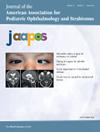Characteristics, associations, and outcomes of children with posterior segment coloboma
IF 1.2
4区 医学
Q3 OPHTHALMOLOGY
引用次数: 0
Abstract
Purpose
To describe the clinical characteristics and outcomes of children with posterior segment coloboma (PSC).
Methods
The medical records of children (age <18 years) with PSC examined at Boston Children’s Hospital from May 1997 to May 2023 were reviewed retrospectively. The following data were collected: demographics, ocular and systemic conditions, coloboma type according to the Ida Mann (IM) classification, and best-corrected visual acuity. Rate of retinal detachment (RD) was calculated. A t test was used to compare visual outcomes by coloboma classification. Logistic regression was used to evaluate the association of CHARGE syndrome with coloboma classification and laterality.
Results
A total of 501 eyes of 343 patients were included. Differences in the mean best-corrected visual acuity of eyes with large PSC (IM type 1-3) and moderate-to-small PSC (IM type 4-7) were found at initial and final examination (both P < 0.001). RD rate was 5% per eye (95% CI, 3.25-7.28) and 7.3% per patient (95% CI, 4.77-10.57). After adjusting for covariates, children with CHARGE syndrome were at increased odds of having IM type 1, type 2, or type 3 colobomas (OR = 2.5; 95% CI, 1.4-4.8; P = 0.003) and bilateral fundus colobomas (OR = 7.0; 95% CI, 3.4-14.5; P <0.001), regardless of IM type, compared to children with PSC and no CHARGE association.
Conclusions
Eyes with large IM colobomas had worse visual outcomes than those with smaller defects; however, both experienced visual impairment. Children with PSC had a low rate of RD. Children with CHARGE syndrome often presented with bilateral and large IM colobomatous defects.
后段巨脑瘤患儿的特征、关联性和预后。
目的:描述后节巨脑症(PSC)患儿的临床特征和预后:结果结果:共纳入 343 名患者的 501 只眼睛。在初次检查和最终检查中发现,大型 PSC(IM 型 1-3)和中型至小型 PSC(IM 型 4-7)患者的平均最佳矫正视力存在差异(均为 P <0.001)。每只眼睛的 RD 率为 5%(95% CI,3.25-7.28),每名患者的 RD 率为 7.3%(95% CI,4.77-10.57)。调整协变量后,CHARGE 综合征患儿出现 1 型、2 型或 3 型 IM 胶状瘤(OR = 2.5;95% CI,1.4-4.8;P = 0.003)和双侧眼底胶状瘤(OR = 7.0;95% CI,3.4-14.5;P 结论:CHARGE 综合征患儿出现 1 型、2 型或 3 型 IM 胶状瘤的几率增加:有较大IM巨瘤的患儿比有较小缺陷的患儿视力更差,但两者都有视力障碍。PSC患儿的RD率较低。患有CHARGE综合征的儿童通常伴有双侧和较大的IM胶质瘤缺陷。
本文章由计算机程序翻译,如有差异,请以英文原文为准。
求助全文
约1分钟内获得全文
求助全文
来源期刊

Journal of Aapos
医学-小儿科
CiteScore
2.40
自引率
12.50%
发文量
159
审稿时长
55 days
期刊介绍:
Journal of AAPOS presents expert information on children''s eye diseases and on strabismus as it affects all age groups. Major articles by leading experts in the field cover clinical and investigative studies, treatments, case reports, surgical techniques, descriptions of instrumentation, current concept reviews, and new diagnostic techniques. The Journal is the official publication of the American Association for Pediatric Ophthalmology and Strabismus.
 求助内容:
求助内容: 应助结果提醒方式:
应助结果提醒方式:


